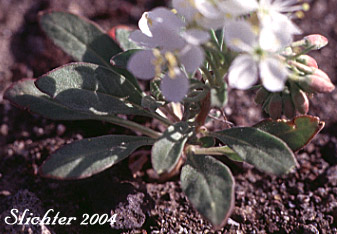Club-fruited evening-primrose is an annual to winter-annual wildflower with a cluster of basal leaves and erect to spreading stems. The stems may be simple or branched near the base (or on the middle and upper stems in some varieties) and arise 10-40 cm high. The central stem is often erect while the side stems may be ascending. The herbage varies from mostly glabrous to partly glandular to covered with straight, stiff, sharp and appressed hairs. The leaves range from mostly basal to also distributed onto the lower to midstem. The lower leaves are long petiolate, the upper ones becoming sessile, often reduced in size, and eventually bract-like. The blades are generally ovate to oblong-ovate in shape with the lower leaves from 2-5 cm long.
The numerous flowers are found in elongated, many-flowered racemes at the terminus of each of the stems. The flowers open in the late afternoon or evening and wilt by the following day. The floral tube ranges from 3-8 mm long. The 4 sepals are 3-6 mm long, separate, and reflexed downwards. Each of the 4 white petals is rotund-obovate in shape, lacking notches or clefts in the rounded tips, and they commonly age to pink or rosy-red. The 8 stamens are roughly equal in length, or may be grouped into two slightly different lengths. The anthers range from 1.2-2 mm long. The style is exserted 4-8 mm beyond the opening of the floral tube. This puts the knobby stigma slightly beyond the anthers. The fruits are sessile capsules from 0.8-2 cm long. The capsules are often widest at the base, tapering gradually to the distal tip. The capsules are rarely straight, and are generally arched, abruptly bent or coiled.
Subspecies alyssoides variety alyssoides: Herbage glabrous to covered with fine white, appressed and stiff hairs. Well developed plants simple or branched only from the base. Leaves of midstem more than 2.5 times longer than wide. Fruits coiled or contorted. Usually blooms in May and June. This variety may intergrade with variety villosa.
Subspecies boothii variety boothii: Herbage of fine, short, gland-tipped hairs, or covered with loose, longer whitish hairs up to 1.5 mm long, or a mixture of the two patterns. Plants often freely branched, both from the base as well as at midstem. Stem leaves at midstem 1-2.5 times longer than wide. Fruits wider at the base, often arched near the base. Middle and upper stems more leafy, the midstem leaves longer than 2 cm and about the same length as the lower ones. The leaf margins are usually more toothed than entire. Usually blooms June to September.
Subspecies boothii variety villosa: Herbage of fine, short, gland-tipped hairs, or covered with loose, longer whitish hairs up to 1.5 mm long, or a mixture of the two patterns. Plants often freely branched, both from the base as well as at midstem. Stem leaves at midstem 1-2.5 times longer than wide. Fruits straight, arched or with several sharp curves, not coiled. Usually blooms June to September. Stems less leafy than var. boothii. Midstem leaves usually less than 2 cm long & shorter than the lower leaves. Leaf margins often entire or occasionally toothed. This variety may intergrade with variety alyssoides.
Pine Creek evening-primrose may be found in open areas in the desert on sandy, gravelly or clay soils in the lowlands and basins. It is also found in alkaline soils in the basins as the photos on this page show.
Pine Creek evening-primrose may be found from central Washington south (to the east of the Cascade & Sierra Nevada Mts.) to southern California and Baja California and east through southwestern and south-central Idaho to western Utah and western Arizona.
